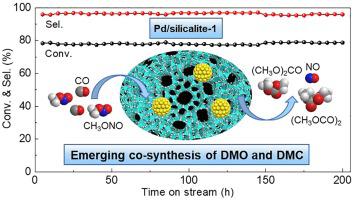当前位置:
X-MOL 学术
›
Chem. Eng. J.
›
论文详情
Our official English website, www.x-mol.net, welcomes your
feedback! (Note: you will need to create a separate account there.)
Emerging co-synthesis of dimethyl oxalate and dimethyl carbonate using Pd/silicalite-1 catalyst with synergistic interactions of Pd and silanols
Chemical Engineering Journal ( IF 13.3 ) Pub Date : 2023-04-25 , DOI: 10.1016/j.cej.2023.143136
Chunzheng Wang , Ningkun Xu , Ke Huang , Bin Liu , Peihua Zhang , Ge Yang , Hailing Guo , Peng Bai , Svetlana Mintova
Chemical Engineering Journal ( IF 13.3 ) Pub Date : 2023-04-25 , DOI: 10.1016/j.cej.2023.143136
Chunzheng Wang , Ningkun Xu , Ke Huang , Bin Liu , Peihua Zhang , Ge Yang , Hailing Guo , Peng Bai , Svetlana Mintova

|
An emerging synthetic route for the co-synthesis of dimethyl oxalate (DMO) and dimethyl carbonate (DMC) via the indirect oxidative carbonylation of CHOH is presented. The promising co-synthesis process combines the advantages of two separate routes of DMO and DMC syntheses. Herein, palladium containing silicalite-1 zeolite (Pd/S-1) catalyst was first found to be highly active and stable for the co-synthesis of DMO and DMC. The catalytic performance strongly depended on the catalyst activation, as the heat treatment could tune the silanols around the Pd species on the silicalite-1 zeolite. The Pd/S-1 catalyst with abundant silanols exhibited a higher turnover frequency (TOF) of 0.18 s and a lower apparent activation energy of 51 kJ mol in comparison to the catalyst with low silanol sites (0.06 s and 101 kJ mol). The best performing catalyst had an average Pd nanoparticle size of 3.2 nm and Pd loading of 0.48 wt%. This catalyst showed a high CO conversion of 78% and DMO + DMC selectivity of 96%, maintaining high stability for at least 200 h. Furthermore, the synergistic interactions of silanols of silicalite-1 zeolite and Pd were confirmed by a series of in situ infrared experiments, and were found to be responsible for the enhanced activity. The silanols of S-1 zeolite played an essential role in forming the Pd active sites and had a very pronounced effect on the adsorption of CO reactant on the Pd species. Understanding the interactions between metal species and silanols of zeolite is critical for the development of high-performance zeolite catalysts.
中文翻译:

利用 Pd/silicalite-1 催化剂通过 Pd 和硅烷醇的协同相互作用共同合成草酸二甲酯和碳酸二甲酯
提出了一种通过 CH3OH 间接氧化羰基化共合成草酸二甲酯 (DMO) 和碳酸二甲酯 (DMC) 的新兴合成路线。这种有前途的共合成工艺结合了 DMO 和 DMC 合成两种不同路线的优点。在此,首次发现含钯硅沸石-1沸石(Pd/S-1)催化剂对于DMO和DMC的共合成具有高活性和稳定性。催化性能很大程度上取决于催化剂的活化,因为热处理可以调节 Silalite-1 沸石上 Pd 物质周围的硅烷醇。与具有低硅烷醇位点的催化剂(0.06 s和101 kJ mol)相比,具有丰富硅烷醇的Pd/S-1催化剂表现出较高的周转频率(TOF)为0.18 s和较低的表观活化能为51 kJ mol。性能最好的催化剂的平均 Pd 纳米颗粒尺寸为 3.2 nm,Pd 负载量为 0.48 wt%。该催化剂表现出高达 78% 的 CO 转化率和 96% 的 DMO + DMC 选择性,并在至少 200 小时内保持高稳定性。此外,一系列原位红外实验证实了silicalite-1沸石的硅烷醇和Pd的协同相互作用,并发现其是活性增强的原因。 S-1沸石的硅烷醇在形成Pd活性位点方面发挥着重要作用,并且对CO反应物在Pd物种上的吸附具有非常显着的影响。了解金属物质和沸石硅烷醇之间的相互作用对于开发高性能沸石催化剂至关重要。
更新日期:2023-04-25
中文翻译:

利用 Pd/silicalite-1 催化剂通过 Pd 和硅烷醇的协同相互作用共同合成草酸二甲酯和碳酸二甲酯
提出了一种通过 CH3OH 间接氧化羰基化共合成草酸二甲酯 (DMO) 和碳酸二甲酯 (DMC) 的新兴合成路线。这种有前途的共合成工艺结合了 DMO 和 DMC 合成两种不同路线的优点。在此,首次发现含钯硅沸石-1沸石(Pd/S-1)催化剂对于DMO和DMC的共合成具有高活性和稳定性。催化性能很大程度上取决于催化剂的活化,因为热处理可以调节 Silalite-1 沸石上 Pd 物质周围的硅烷醇。与具有低硅烷醇位点的催化剂(0.06 s和101 kJ mol)相比,具有丰富硅烷醇的Pd/S-1催化剂表现出较高的周转频率(TOF)为0.18 s和较低的表观活化能为51 kJ mol。性能最好的催化剂的平均 Pd 纳米颗粒尺寸为 3.2 nm,Pd 负载量为 0.48 wt%。该催化剂表现出高达 78% 的 CO 转化率和 96% 的 DMO + DMC 选择性,并在至少 200 小时内保持高稳定性。此外,一系列原位红外实验证实了silicalite-1沸石的硅烷醇和Pd的协同相互作用,并发现其是活性增强的原因。 S-1沸石的硅烷醇在形成Pd活性位点方面发挥着重要作用,并且对CO反应物在Pd物种上的吸附具有非常显着的影响。了解金属物质和沸石硅烷醇之间的相互作用对于开发高性能沸石催化剂至关重要。


































 京公网安备 11010802027423号
京公网安备 11010802027423号